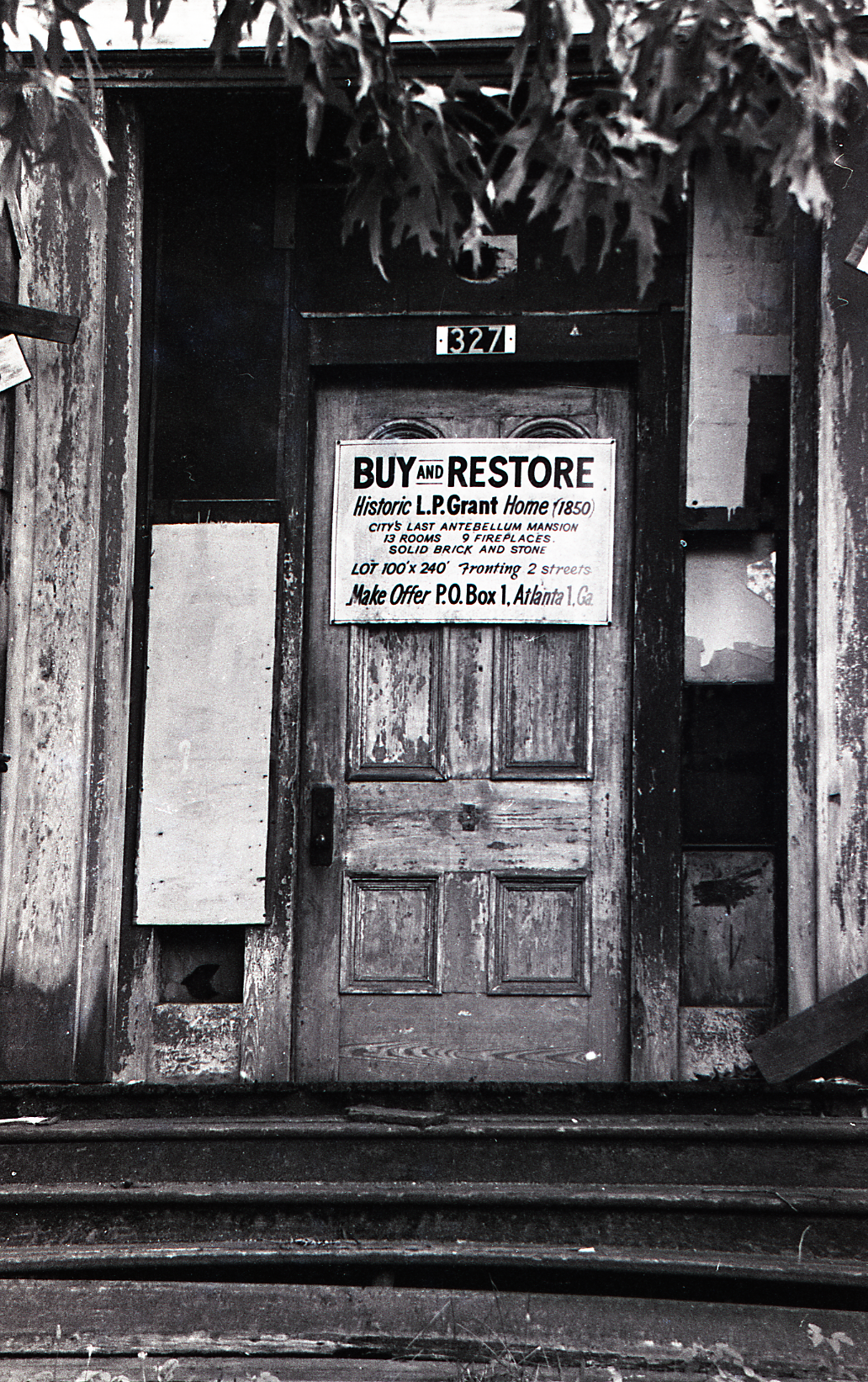< L.P. GRANT MANSION >
L.P. GRANT MANSION
Completed between 1854-1856 and designed by Calvin Fay, the three-story, Italianate mansion was built for Laura Loomis Williams Grant (1820 – 1979) and Lemuel Pratt Grant (1817-1893), a city pioneer, railroad magnate and philanthropist who donated 100 acres to the city of Atlanta for the creation of Grant Park.

L. P. GRANT MANSION
Surviving the Civil War, the house was the 1902 birthplace of golf legend Robert Tyre “Bobby” Jones and its preservation was, at one time, a passion of Margaret Mitchell, the author of Gone with the Wind.
The home sat on 600 acres on what is now the Grant Park neighborhood. The Italianate-style home stood three stories tall with four porches. Exterior and interior walls were constructed with fieldstone and brick with a plaster finish interior and stucco on the exterior. The two-foot-wide walls, 10-foot windows, nine fireplaces, and a ballroom defined this amazing home.
In 1941 Margaret Mitchell loaned money to Boyd Taylor to buy the Grant Mansion for $3,000 and turn it into an Atlanta Museum in order to preserve it. Six years later she sued Taylor, who was supposed to be the caretaker of the house, for letting it deteriorate further, but lost the lawsuit. Then neglect and fire took their toll on the house, and it was left vulnerable and open to the elements.
In December 2001, the Atlanta Preservation Center purchased Atlanta’s most significant and endangered house, the 1856 Lemuel P. Grant Mansion in the Grant Park neighborhood. With this purchase, the Atlanta Preservation Center (“APC”) ensured the historic building’s protection as plans were underway to demolish the Grant Mansion and build two new homes.
In 2001, the selling price for the Grant Mansion was $109,900. The APC raised $140,000 to purchase the house and make it suitable for offices and moved its headquarters there in February 2002. In 2006, the APC completed a stabilization of the historic walls and in 2007 bought an adjoining lot to return the property to its original 1906 boundaries.

Most recently beginning in 2021, the APC has partnered with Savannah-based Landmark Preservation to restore the original window casings, add new glazing, paint, and more – all performed to the Secretary of the Interior’s Standards for the Treatment of Historic Properties. In-kind repairs included performing multiple test samples to identify a stucco material compatible in color, composition, and texture with the original. Ongoing projects include the restoration of the front and back porches.
With assistance and generosity from L.P. Grant’s descendents, dedicated individuals and organizations, and a cadre of skilled crafts people, the Grant Mansion is being returned to its architecturally accurate origins. Here, indeed, is an outstanding example of hands-on preservation of which Atlantans can be proud.
Lemuel P. Grant: From Railroad Engineer to City Builder and Philanthropist
Born in Frankfort, Maine, Lemuel Pratt "L. P." Grant came to Atlanta in 1840 as a railroad engineer and over the next 40 years prospered as he built Georgia’s railroads and secured Atlanta’s place as a railroad center. Promoted through the ranks, Grant became president of the Atlanta and West Point Railway (1881-87) and the Western Railroad of Alabama (1883-87), and helped incorporate several other railroads along the way.
In 1843, Grant invested in land in what is now Southeast Atlanta, paying from $.75 to $2 an acre, and built his home in the center of his 600+ acres. In 1883, Grant donated 100 acres to the City of Atlanta for the establishment of a city park open and available to residents of any race, creed or color. Grant also gave land on Jenkins Street for Atlanta's first Black church, Bethel Church (now Big Bethel Baptist Church), and defended the church’s right to the property after the Civil War.
After the Civil War, Grant worked hard to enhance life in his adopted city. He served as a member of the Atlanta City Council, Water Commission, Board of Education and committee to draft a new charter. In addition to giving the land for Grant Park in 1882, he sold the property for a public hospital where Grady now stands below market value and contributed thousands of dollars to it. Elected an honorary member of the Young Men’s Library Association, Grant donated an American Cyclopedia and funds for books. In addition, he was an active member of Central Presbyterian Church.
Grant was married to Laura L. Williams of Decatur for 36 years. Their four children were John A Grant; Myra Grant, who married William B. Armstrong; Lemuel Pratt Grant Jr.; and Lettie Grant, who married George Logan. When Mrs. Grant died in 1879, L.P. Grant wrote: “My house escaped the torch which was so generally applied by Sherman’s hosts on leaving Atlanta. The surroundings are rather attractive, especially the lawn and grove in front. But the light of the household has left us for a better country, where wars and suffering shall never come. My dear wife died on the 25th of May last year. ... The house is so desolate to me though filled with children and grandchildren, who vie with each other in kindness.”
In 1881 Grant married Jane L. Crew and moved to a house on Hill Street built by his son John. When Grant died in 1893, he was recognized as one of Atlanta’s “best friends, one of her noblest citizens and one of her chief benefactors” by The Atlanta Journal.
After Grant’s death in 1893, the first Grant Mansion continued in the possession of his family. His grandson Bryan M. and wife shared their home with Mr. and Mrs. Robert P. Jones whose son Robert Tyre “Bobby” Jones, the greatest amateur golfer in the world and winner of the grand slam in 1930, was born in 1902. The 1930’s tennis champion Bryan M. “Bitsy” Grant Jr. was Grant’s great-grandson.
DIRECTIONS
Address
327 St. Paul Ave. SE, Atlanta, GA 30312
Hours
Sun-Sat 10am - 5pm
Contact Info
+1 (404) 688-3353













